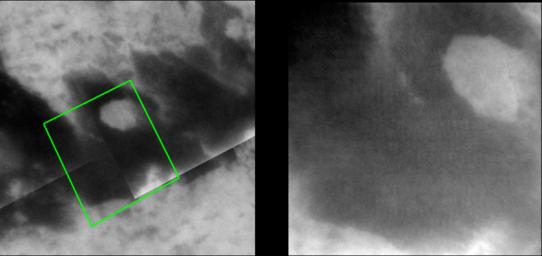
|
Angular Bright Spot
- Click the image above for a larger view
- Full-Res JPEG (1088 x 514) (59.5 kB)
- Full-Res TIFF (1088 x 514) (1.7 MB)
Caption:
A new image of Titan taken by Cassini provides a closer, clearer view of an interesting bright feature surrounded by darker material.
During the two most recent flybys of Titan, on March 31 and April 16, 2005, Cassini captured a number of images of the hemisphere of Titan that faces Saturn. The image at the left is taken from a mosaic of images obtained in March 2005 (see PIA06222 ) and shows the location of the new image at the right. The image at the right shows an intriguing bright spot as well as the southern boundary of the dark terrain that dominates the equatorial region of this hemisphere of Titan.
The 80-kilometer-wide (50-mile) bright spot seen in the upper right portion of the image at the left was first seen in images taken during a distant encounter with Titan shortly after Cassini's Saturn orbit insertion burn in July 2004. In images taken in March, this spot was shown to be roughly circular but new, higher-resolution images like the one at the right reveal surprisingly angular edges. The angular margins suggest that they have been influenced by tectonic processes (for example, faulting). The sharp western margins and more diffuse bright material off the eastern margin are consistent with bright features seen within dark terrain in the region of Titan observed during previous flybys late last year and in February (see PIA06541 ). The west-east nature of these features is consistent with "wakes" being formed through wind-driven activity. It is also worth noting that this bright spot appears to be partly surrounded by thin, curving tendrils of bright material.
The view at the left consists of five images that have been added together and enhanced to bring out surface detail and to reduce noise, although some camera artifacts remain.
These images were taken with the Cassini spacecraft narrow-angle camera using a filter sensitive to wavelengths of infrared light centered at 938 nanometers -- considered to be the imaging science subsystem's best spectral filter for observing the surface of Titan. This view was acquired from a distance of approximately 43,000 kilometers (26,700 miles). The pixel scale of this image is 510 meters (0.3 miles) per pixel, although the actual resolution is likely to be several times larger.
Background Info:
The Cassini-Huygens mission is a cooperative project of NASA, the European Space Agency and the Italian Space Agency. The Jet Propulsion Laboratory, a division of the California Institute of Technology in Pasadena, manages the mission for NASA's Science Mission Directorate, Washington, D.C. The Cassini orbiter and its two onboard cameras were designed, developed and assembled at JPL. The imaging team is based at the Space Science Institute, Boulder, Colo.
For more information about the Cassini-Huygens mission visit http://saturn.jpl.nasa.gov . For additional images visit the Cassini imaging team homepage http://ciclops.org .
Cataloging Keywords:
| Name | Value | Additional Values |
|---|---|---|
| Target | Titan | Saturn |
| System | Saturn | |
| Target Type | Satellite | Planet |
| Mission | Cassini-Huygens | |
| Instrument Host | Cassini Orbiter | |
| Host Type | Orbiter | |
| Instrument | Imaging Science Subsystem (ISS) | |
| Detector | Narrow Angle Camera | |
| Extra Keywords | Color, Infrared, Visual | |
| Acquisition Date | ||
| Release Date | 2005-05-02 | |
| Date in Caption | 2005-04-16 | |
| Image Credit | NASA/JPL/Space Science Institute | |
| Source | photojournal.jpl.nasa.gov/catalog/PIA06233 | |
| Identifier | PIA06233 | |
